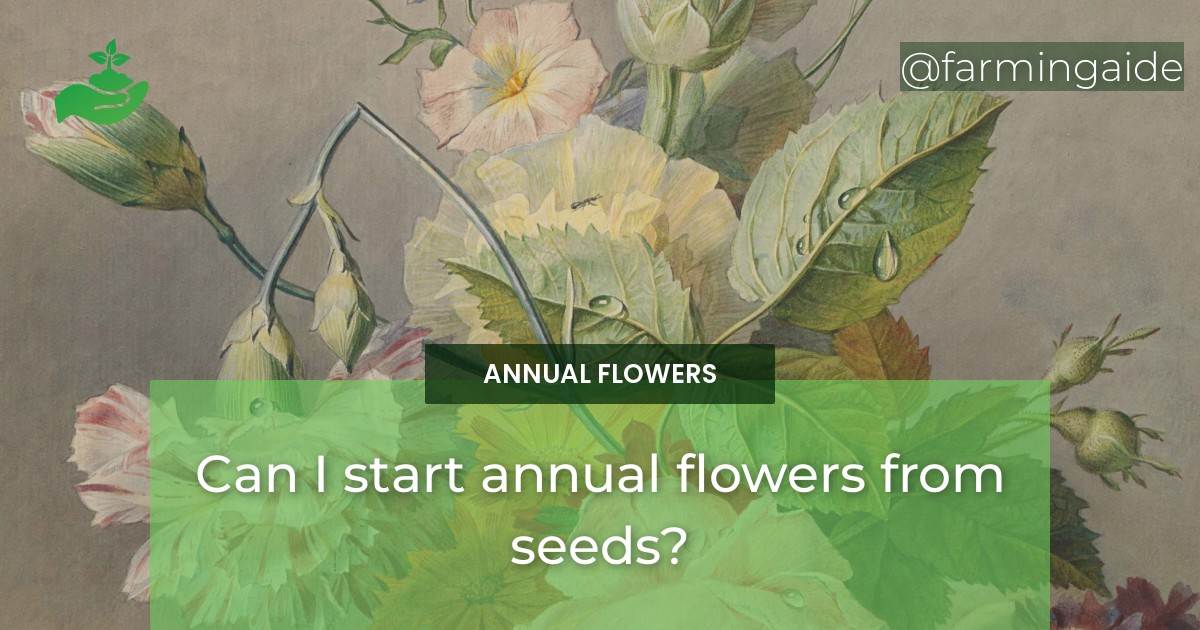Starting annual flowers from seeds is a great way to add color and beauty to your garden without breaking the bank. It may seem intimidating to start seeds indoors, but with a little patience and attention, anyone can successfully grow beautiful annual flowers from seeds. In this article, we will cover the benefits of starting annual flowers from seeds, what types of flowers can be started from seeds, and the steps you need to follow to grow healthy and strong seedlings.
Introduction to Starting Annual Flowers from Seeds
When you start annual flowers from seeds, you have more control over the plants’ growth and development. You can choose the seeds you want to grow, and you can control the amount of light, water, and nutrients they receive. Starting seeds indoors also means that you can extend your growing season, giving your plants a head start on the season. Plus, growing from seed can be more cost-effective than buying transplants.
Most annual flowers can be started from seeds, including popular varieties such as marigolds, zinnias, cosmos, petunias, and sunflowers. Some annuals are better suited for direct planting in the garden, while others are best started indoors.
Steps to Successfully Grow Annual Flowers from Seeds
Step 1 – Choosing the Right Seeds
The first step in growing annual flowers from seeds is choosing the right seeds. Here are some factors to consider when making your selection:
- Choose seeds that are fresh and have been stored properly. Old seeds or seeds that have been exposed to moisture may not germinate well.
- Consider the lighting requirements of the plants. Some annual flowers, like marigolds, prefer full sun, while others, like impatiens, need more shade. Choose seeds that suit the conditions in your garden.
- Look for varieties that are disease-resistant or have other desirable traits, such as longer blooming periods or unusual colors.
Popular annual flowers that are easy to start from seeds include:
- Marigolds
- Zinnias
- Petunias
- Cosmos
- Impatiens
- Nasturtiums
Step 2 – Seed Starting Indoors
Once you’ve chosen your seeds, it’s time to start them indoors. Here are the supplies you’ll need:
- Seed starting trays or pots
- Seed starting mix
- Seeds
- Grow lights or a sunny windowsill
- Watering can or spray bottle
Here are some tips for starting seeds indoors:
- Moisten the seed starting mix before sowing your seeds. This will help ensure good seed-to-soil contact.
- Follow the seed packet instructions for planting depth and spacing.
- Keep the soil moist but not waterlogged. Water from the bottom of the tray to avoid disturbing the seeds.
- Provide adequate light. If you’re using a windowsill, make sure it gets at least six hours of direct sunlight per day. If you’re using grow lights, keep them on for 16 hours per day.
- Use a fan to circulate air around your seedlings. This will help prevent disease and promote strong stems.
- Keep the temperature between 60-75°F. This will help ensure good germination rates.
Common mistakes to avoid when starting seeds indoors include overwatering, not providing enough light, and starting your seeds too early.
Step 3 – Transplanting Seedlings
When your seedlings have grown to be a few inches tall and have several sets of true leaves, it’s time to transplant them into larger containers or into the garden. Here’s what you need to know:
- Transplant seedlings on a cloudy day or in the late afternoon to minimize stress to the plants.
- Use a high-quality potting mix when transplanting.
- When transplanting into the garden, loosen the soil and add compost to help improve soil health and drainage.
- Space your plants according to their mature size to prevent overcrowding.
- Water your seedlings immediately after transplanting to help them settle into their new home.
Hardening off your seedlings before transplanting them into the garden is crucial. This means gradually exposing them to outdoor conditions, such as wind and direct sunlight, so they can acclimate to their new environment.
Step 4 – Caring for Young Seedlings
Once your seedlings are transplanted, it’s important to care for them properly. Here are some tips:
- Water your seedlings regularly, making sure the soil stays moist but not waterlogged.
- Fertilize your seedlings with a balanced fertilizer once a month.
- Protect your seedlings from pests and diseases by keeping your garden clean and removing any dead or diseased plant material.
- Keep an eye out for common issues like damping off, which is caused by a fungal infection and can cause seedlings to wither and die. Be sure not to overwater, as this can make the problem worse.
Will Fertilizing My Annual Flowers Help with Starting Them from Seeds?
Yes, fertilizing annual flowers schedule will certainly help in starting them from seeds. By providing the necessary nutrients at the right times, you can promote healthy growth and greater chances of successful germination. Following a proper fertilizing annual flowers schedule can greatly improve the overall outcome of your seeds.
Conclusion
Starting annual flowers from seeds can be a rewarding and cost-effective way to add beauty to your garden. With the right seeds, supplies, and care, you can grow healthy and strong seedlings that will flourish throughout the season. Don’t be afraid to experiment with different types of annual flowers and seed starting techniques to find what works best for you. With a little patience and practice, you’ll soon be a pro at starting annual flowers from seeds.


